
Caryophyllaceae, commonly called the pink family or carnation family, is a family of flowering plants. It is included in the dicotyledon order Caryophyllales in the APG III system, alongside 33 other families, including Amaranthaceae, Cactaceae, and Polygonaceae. It is a large family, with 81 genera and about 2,625 known species.

Allium tricoccum is a bulbous perennial flowering plant in the amaryllis family Amaryllidaceae. It is a North American species of wild onion or garlic widespread across eastern Canada and the eastern United States. Many of the common English names for this plant are also used for other Allium species, particularly the similar Allium ursinum, which is native to Europe and Asia. An edible plant, Allium tricoccum is used in a variety of North American and indigenous cuisines, and has also been used by Native Americans in traditional medicine.

Stellaria is a genus of about 190 species of flowering plants in the family Caryophyllaceae, with a cosmopolitan distribution. Common names include starwort, stitchwort and chickweed.

Lysimachia europaea is a flowering plant in the primrose family Primulaceae, called by the common name chickweed-wintergreen or arctic starflower. It is a small herbaceous perennial plant with one or more whorls of leaves on a single slender erect stem. It is about one third of a foot high (10 cm). The broad lanceolate leaves are pale green but take on a copper hue in late summer. The solitary white flowers are reminiscent of small wood anemones and appear in midsummer. The fruits are globular dry capsules but are seldom produced.
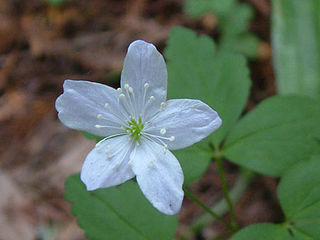
Anemonoides quinquefolia, a flowering plant in the buttercup family Ranunculaceae, is native to North America. It is commonly called wood anemone or windflower, not to be confused with Anemonoides nemorosa, a closely related European species also known by these common names. The specific epithet quinquefolia means "five-leaved", which is a misnomer since each leaf has just three leaflets. A plant typically has a single, small white flower with 5 sepals.

Cardamine hirsuta, commonly called hairy bittercress, is an annual or biennial species of plant in the family Brassicaceae, and is edible as a salad green. It is common in moist areas around the world.
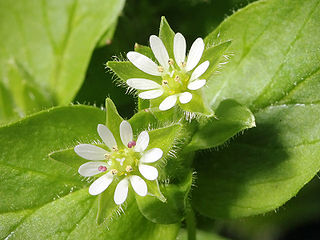
Stellaria media, chickweed, is an annual flowering plant in the family Caryophyllaceae. It is native to Eurasia and naturalized throughout the world, where it is a weed of waste ground, farmland and gardens. It is sometimes grown as a salad crop or for poultry consumption.
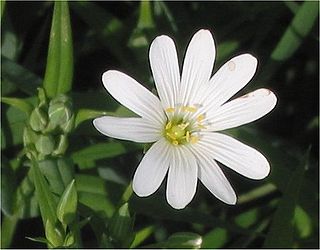
Rabelera holostea, known as greater stitchwort, greater starwort, and addersmeat, is a perennial herbaceous flowering plant in the family Caryophyllaceae. It was formerly placed in the genus Stellaria, as Stellaria holostea, but was transferred to the genus Rabelera in 2019 based on phylogenetic analyses. It is the only species in the genus Rabelera. Greater stitchwort is native to Western and Central Europe, including the British Isles.

Stellaria pubera, commonly called the star chickweed, is a spring-flowering plant in the carnation family Caryophyllaceae, native to the eastern United States.

Stellaria graminea is a species of flowering plant in the family Caryophyllaceae known by the common names common starwort, grass-leaved stitchwort, lesser stitchwort and grass-like starwort.

Cerastium fontanum, also called mouse-ear chickweed, common mouse-ear, or starweed, is a species of mat-forming perennial or, rarely, annual plant. It is native to Europe but introduced elsewhere. Its identifying characteristics are tear-shaped leaves growing opposite one another in a star pattern, hairy leaves, and small white flowers. Mouse-ear chickweed typically grows to 4"-8" tall and spreads horizontally along the ground via the formation of roots wherever the stem falls over and contacts the ground.
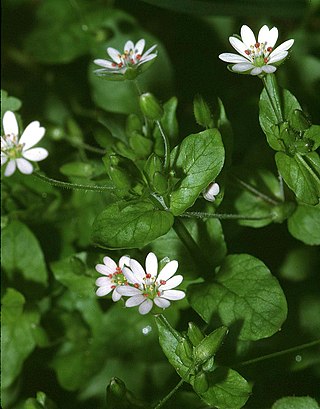
Stellaria neglecta, greater chickweed, is an annual to short-lived herbaceous perennial flowering plant in the family Caryophyllaceae. It is native to Europe and Asia, where it grows in hedges and woodland margins on neutral to slightly acid, damp soils, and is widespread but rarely abundant. It has been introduced to North America, where it has been spreading in recent decades.

Stellaria apetala, lesser chickweed, is an annual herbaceous plant in the flowering plant family Caryophyllaceae. It occurs in short, sandy grassland by the sea and, less often, in similar habitat inland. It is native to Europe and is well established as an introduced species worldwide.

Stellaria nitens is a species of flowering plant in the family Caryophyllaceae known by the common names shiny chickweed and shining starwort. It is native to western North America, including British Columbia, Alberta, and the western United States, its distribution extending into Mexico at least as far as Baja California. It grows in many types of habitat, in dry and moist areas, and sometimes in disturbed places. It is an annual herb producing a slender, upright, four-angled stem from a thin taproot, reaching up to about 25 centimeters in height. Most of the leaves are located low on the stem, each measuring up to 1.5 centimeters long, with smaller, narrower leaves occurring above. The leaves are hairless except for some rough hairs along the margins, and the blades have shiny surfaces. The inflorescence bears a few flowers on short pedicels. The flower has five pointed sepals each a few millimeters long. There are sometimes five tiny white petals as well, though these are often absent.

Stellaria obtusa is a species of flowering plant in the family Caryophyllaceae known by the common names Rocky Mountain chickweed, blunt-sepaled starwort, and obtuse starwort. It is native to western North America, from British Columbia and Alberta to California to Colorado, where it grows in moist areas in forests and on mountain slopes.
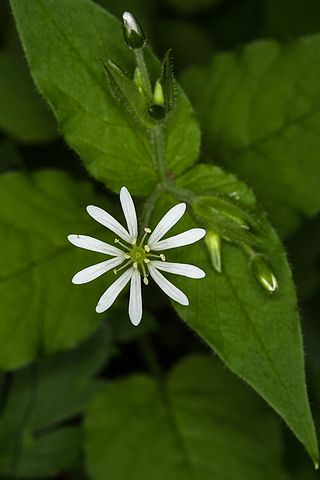
Stellaria nemorum, also known by the common name wood stitchwort, is a stoloniferous herbaceous perennial flowering plant in the family Caryophyllaceae.

Stellaria alsine, the bog stitchwort, is a species of herbaceous perennial flowering plant in the carnation family Caryophyllaceae. It grows in bogs and marshes in Europe and parts of North America.

Stellaria pungens, commonly known as prickly starwort, is a flowering plant in the family Caryophyllaceae and is endemic to eastern Australia. It is a small, mat forming perennial with white star-shaped flowers and small sharply pointed, bright green leaves.

















